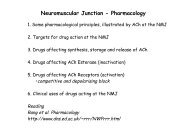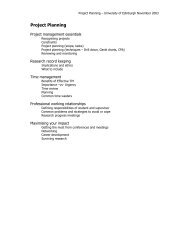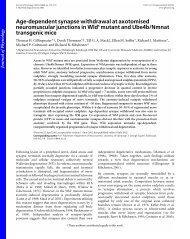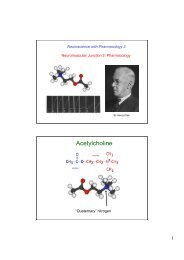Physiology and Pathophysiology of Neuromuscular Transmission
Physiology and Pathophysiology of Neuromuscular Transmission
Physiology and Pathophysiology of Neuromuscular Transmission
You also want an ePaper? Increase the reach of your titles
YUMPU automatically turns print PDFs into web optimized ePapers that Google loves.
EPC’s sum linearly : EPP’s sum non-linearly<br />
McLachlan EM, Martin AR. Non-linear summation <strong>of</strong> end-plate potentials in the frog<br />
<strong>and</strong> mouse. J Physiol. 1981 Feb;311:307-24.PMID: 6267255<br />
Correction Factors<br />
Martin (1955):<br />
v' = v /(1! v /(E m<br />
! E r<br />
)<br />
m =<br />
q(1 ! v ! (E m<br />
! E r<br />
)<br />
v= EPP amplitude<br />
q= MEPP amplitude<br />
m = quantal content<br />
v' = v /(1! fv(E m<br />
! E r<br />
)<br />
v !<br />
McLachlan & Martin (1981)<br />
Where f = an empirically determined ('fudge’) factor<br />
For mouse muscle, long fibres: f=0.8<br />
For frog muscle, long fibres: f=0.55<br />
For short muscle fibres (e.g. FDB) the correction is unknown, but<br />
f=0.3 gives a good fit to our data.<br />
<strong>Physiology</strong> <strong>and</strong> <strong>Pathophysiology</strong> <strong>of</strong><br />
<strong>Neuromuscular</strong> <strong>Transmission</strong><br />
1. Botulism <strong>and</strong> Myasthenias<br />
2. Characteristics <strong>of</strong> MEPPS <strong>and</strong> EPPS<br />
3. Quantal analysis<br />
4. Synaptic strength <strong>and</strong> safety factor<br />
24








